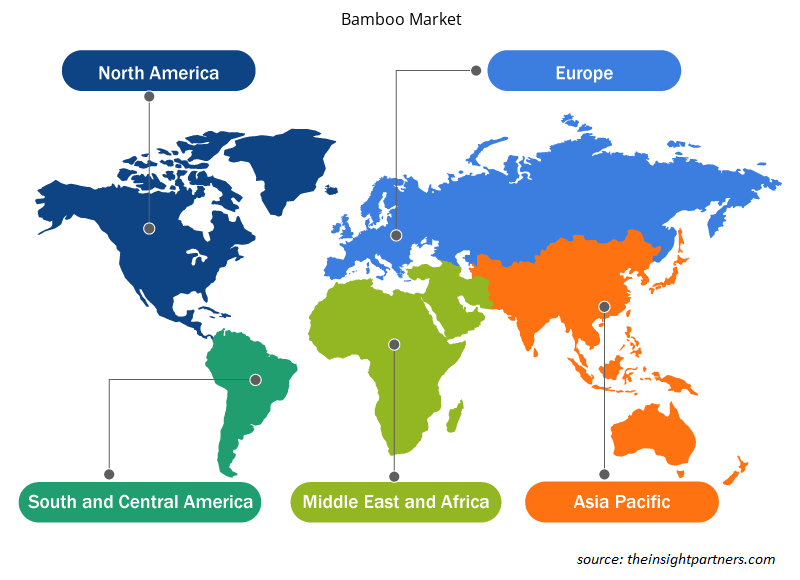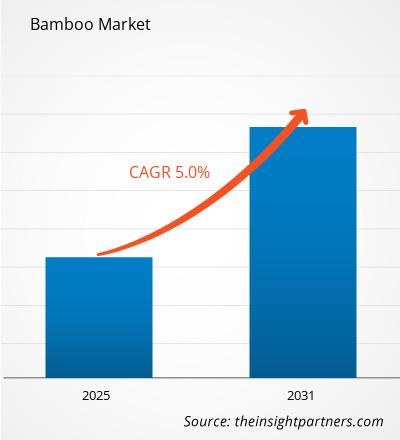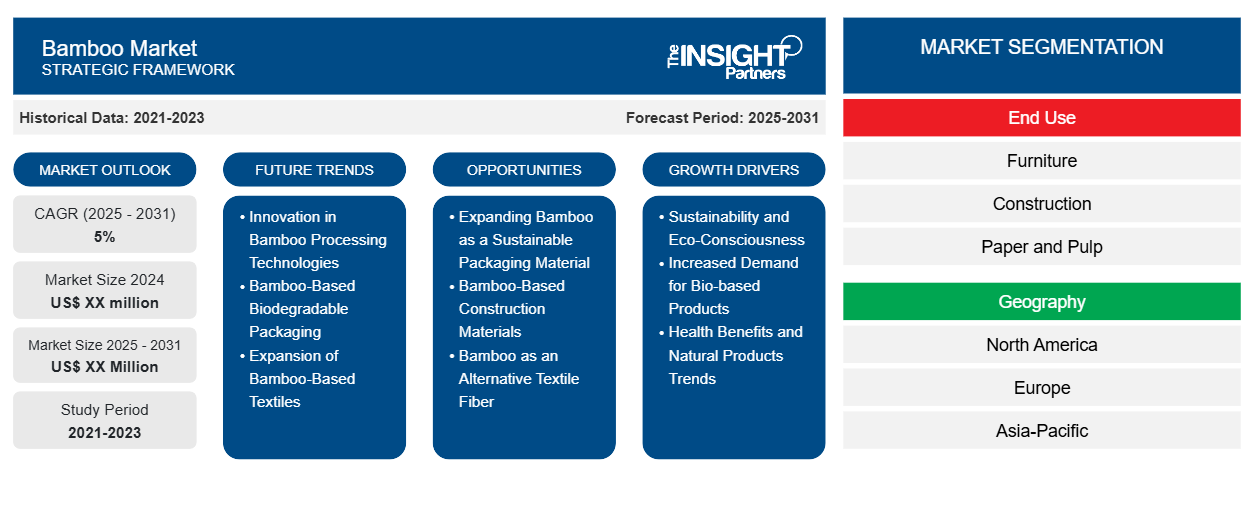Si prevede che il mercato del bambù registrerà un CAGR del 5% dal 2023 al 2031, con una dimensione del mercato in espansione da XX milioni di dollari nel 2023 a XX milioni di dollari entro il 2031.
Il rapporto presenta un'analisi basata sull'uso finale (mobili, edilizia, carta e cellulosa, biomassa, tessile e altri). L'analisi globale è ulteriormente suddivisa a livello regionale e nei principali paesi. L'analisi globale è ulteriormente suddivisa a livello regionale e nei principali paesi. Le dimensioni del mercato e le previsioni a livello globale, regionale e nazionale per tutti i principali segmenti di mercato sono coperte nell'ambito. Il rapporto offre il valore in USD per l'analisi e i segmenti di cui sopra. Il rapporto fornisce statistiche chiave sullo stato di mercato dei principali attori del mercato e offre tendenze e opportunità di mercato.
Scopo del rapporto
Il report Bamboo Market di The Insight Partners mira a descrivere il panorama attuale e la crescita futura, i principali fattori trainanti, le sfide e le opportunità. Ciò fornirà spunti a vari stakeholder aziendali, come:
- Fornitori/produttori di tecnologia: per comprendere le dinamiche di mercato in evoluzione e conoscere le potenziali opportunità di crescita, consentendo loro di prendere decisioni strategiche informate.
- Investitori: condurre un'analisi completa delle tendenze in merito al tasso di crescita del mercato, alle proiezioni finanziarie del mercato e alle opportunità esistenti lungo la catena del valore.
- Enti di regolamentazione: regolamentano le politiche e le attività di controllo sul mercato allo scopo di ridurre al minimo gli abusi, preservare la fiducia degli investitori e sostenere l'integrità e la stabilità del mercato.
Segmentazione del mercato del bambù
Uso finale
- Mobilia
- Costruzione
- Carta e cellulosa
- Biomassa
- Tessile
- Altri
Personalizza questo report in base alle tue esigenze
Riceverai la personalizzazione gratuita di qualsiasi report, comprese parti di questo report, o analisi a livello nazionale, pacchetto dati Excel, oltre a usufruire di grandi offerte e sconti per start-up e università
-
Scopri le principali tendenze di mercato in questo rapporto.Questo campione GRATUITO includerà analisi di dati che spaziano dalle tendenze di mercato alle stime e alle previsioni.
Fattori di crescita del mercato del bambù
- Sostenibilità ed eco-coscienza: il bambù è riconosciuto come un'alternativa ecologica ai materiali tradizionali come legno, plastica e metallo. Con le crescenti preoccupazioni sulla deforestazione, il cambiamento climatico e i rifiuti di plastica, la natura rinnovabile del bambù lo rende una scelta attraente nei settori dell'arredamento, tessile e delle costruzioni. La crescente preferenza dei consumatori per i prodotti sostenibili sta guidando la domanda di beni a base di bambù.
- Aumento della domanda di prodotti biologici: con l'intensificarsi del passaggio globale verso alternative sostenibili ed ecologiche, il bambù viene sempre più visto come una soluzione praticabile per imballaggi, tessuti e altri beni di consumo. La versatilità del materiale, unita al suo impatto ambientale minimo, ne sta spingendo l'uso in vari settori, tra cui imballaggi e mobili biodegradabili.
- Benefici per la salute e tendenze dei prodotti naturali: il bambù sta guadagnando popolarità nei mercati attenti alla salute grazie alle sue proprietà ipoallergeniche, antimicrobiche e naturalmente antibatteriche. Ciò ha portato alla sua incorporazione in tessuti, prodotti per la cura della persona e articoli per il benessere come spazzolini da denti e biancheria da letto a base di bambù. Poiché i consumatori danno sempre più priorità ai prodotti orientati alla salute, cresce la domanda di alternative a base di bambù.
Tendenze future del mercato del bambù
- Innovazione nelle tecnologie di lavorazione del bambù: lo sviluppo di tecniche di lavorazione avanzate sta consentendo la creazione di prodotti in bambù di qualità superiore, come tessuti, pavimenti e materiali da costruzione più resistenti e durevoli. Si prevede che queste innovazioni amplieranno il mercato del bambù in nuove applicazioni come materiali da costruzione ad alte prestazioni e imballaggi eco-compatibili.
- Imballaggi biodegradabili a base di bambù: con l'aumento delle preoccupazioni sull'inquinamento da plastica, il bambù sta emergendo come una valida alternativa per le soluzioni di imballaggio biodegradabili. Con un numero sempre maggiore di aziende che passano a pratiche sostenibili, si prevede che la domanda di imballaggi in bambù aumenterà, in particolare nei settori alimentare e dei beni di consumo, rendendo il bambù un materiale chiave nell'economia circolare.
- Espansione dei tessuti a base di bambù: il bambù è sempre più utilizzato nell'industria tessile per la sua morbidezza, durevolezza e sostenibilità. Si prevede che il mercato dei tessuti a base di bambù, come la viscosa di bambù, crescerà man mano che i consumatori richiederanno più abbigliamento e tessuti per la casa ecosostenibili. Questa tendenza è alimentata dalla crescente consapevolezza della moda sostenibile.
Opportunità di mercato del bambù
- Espandere il bambù come materiale di imballaggio sostenibile: la spinta globale verso la sostenibilità presenta un'importante opportunità per il bambù negli imballaggi. Poiché sempre più settori cercano alternative ecologiche alla plastica, la natura a rapida crescita del bambù e la sua biodegradabilità lo rendono una scelta interessante per i materiali di imballaggio, in particolare nei settori alimentare e delle bevande.
- Materiali da costruzione a base di bambù: la durevolezza e la resistenza del bambù lo rendono un materiale ideale per l'edilizia sostenibile. La crescente attenzione alle pratiche di edilizia ecologica e allo sviluppo di infrastrutture eco-consapevoli offre un'enorme opportunità di mercato per il bambù nel settore edile, soprattutto nei mercati emergenti in cui la domanda di alloggi accessibili ed eco-compatibili è in aumento.
- Il bambù come fibra tessile alternativa: con la crescente consapevolezza dei consumatori nei confronti della moda sostenibile, il bambù sta diventando un'alternativa preferita ai tessuti convenzionali come il cotone e le fibre sintetiche. La crescita del movimento della moda sostenibile offre l'opportunità di utilizzare le fibre di bambù nell'abbigliamento, nei tessuti per la casa e in altri prodotti in tessuto, stimolando l'espansione del mercato.
Approfondimenti regionali sul mercato del bambù
Le tendenze regionali e i fattori che influenzano il mercato del bambù durante il periodo di previsione sono stati ampiamente spiegati dagli analisti di Insight Partners. Questa sezione discute anche i segmenti e la geografia del mercato del bambù in Nord America, Europa, Asia Pacifico, Medio Oriente e Africa, e Sud e Centro America.

- Ottieni i dati specifici regionali per il mercato del bambù
Ambito del rapporto sul mercato del bambù
| Attributo del report | Dettagli |
|---|---|
| Dimensioni del mercato nel 2023 | XX milioni di dollari USA |
| Dimensioni del mercato entro il 2031 | XX milioni di dollari USA |
| CAGR globale (2023-2031) | 5% |
| Dati storici | 2021-2022 |
| Periodo di previsione | 2024-2031 |
| Segmenti coperti |
Per uso finale
|
| Regioni e Paesi coperti |
America del Nord
|
| Leader di mercato e profili aziendali chiave |
|
Densità degli operatori del mercato del bambù: comprendere il suo impatto sulle dinamiche aziendali
Il mercato del Bamboo Market sta crescendo rapidamente, spinto dalla crescente domanda degli utenti finali dovuta a fattori quali l'evoluzione delle preferenze dei consumatori, i progressi tecnologici e una maggiore consapevolezza dei benefici del prodotto. Con l'aumento della domanda, le aziende stanno ampliando le loro offerte, innovando per soddisfare le esigenze dei consumatori e capitalizzando sulle tendenze emergenti, il che alimenta ulteriormente la crescita del mercato.
La densità degli operatori di mercato si riferisce alla distribuzione di aziende o società che operano in un particolare mercato o settore. Indica quanti concorrenti (operatori di mercato) sono presenti in un dato spazio di mercato in relazione alle sue dimensioni o al valore di mercato totale.
Le principali aziende che operano nel mercato del bambù sono:
- MOSO International BV
- Gruppo Dasso
- Shanghai Tenbro Bamboo Textile Co., Ltd.,
- Società del villaggio di bambù limitata
- Azienda Xiamen HBD Industry & Trade Co., Ltd.
Disclaimer : le aziende elencate sopra non sono classificate secondo un ordine particolare.

- Ottieni una panoramica dei principali attori del mercato del bambù
Punti chiave di vendita
- Copertura completa: il rapporto affronta in modo completo l'analisi dei prodotti, dei servizi, delle tipologie e degli utenti finali del mercato del bambù, fornendo una panoramica olistica.
- Analisi degli esperti: il rapporto è compilato sulla base della conoscenza approfondita di esperti e analisti del settore.
- Informazioni aggiornate: il rapporto garantisce la pertinenza aziendale grazie alla copertura di informazioni recenti e tendenze nei dati.
- Opzioni di personalizzazione: questo report può essere personalizzato per soddisfare le esigenze specifiche del cliente e adattarsi in modo appropriato alle strategie aziendali.
Il rapporto di ricerca sul mercato del bambù può quindi aiutare a guidare il percorso di decodificazione e comprensione dello scenario del settore e delle prospettive di crescita. Sebbene possano esserci alcune preoccupazioni valide, i vantaggi complessivi di questo rapporto tendono a superare gli svantaggi.
- Analisi storica (2 anni), anno base, previsione (7 anni) con CAGR
- Analisi PEST e SWOT
- Valore/volume delle dimensioni del mercato - Globale, Regionale, Nazionale
- Industria e panorama competitivo
- Set di dati Excel
Report recenti
Testimonianze
Motivo dell'acquisto
- Processo decisionale informato
- Comprensione delle dinamiche di mercato
- Analisi competitiva
- Analisi dei clienti
- Previsioni di mercato
- Mitigazione del rischio
- Pianificazione strategica
- Giustificazione degli investimenti
- Identificazione dei mercati emergenti
- Miglioramento delle strategie di marketing
- Aumento dell'efficienza operativa
- Allineamento alle tendenze normative























 Ottieni un campione gratuito per - Mercato del bambù
Ottieni un campione gratuito per - Mercato del bambù